2019 Chevrolet Silverado 1500 High Country vs. 2019 Ford F-150 Limited vs. 2019 Ram 1500 Limited
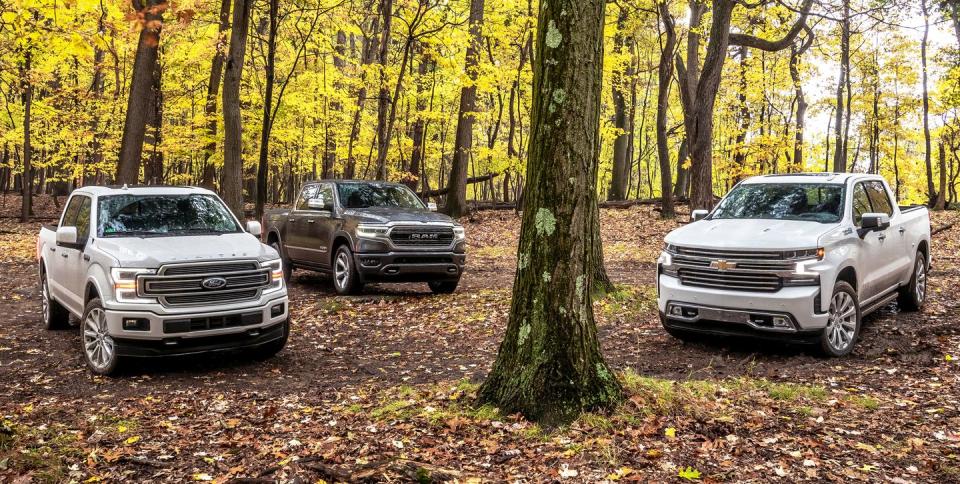
From the January 2019 issue
In 2017, Americans bought more full-size pickups than people did new vehicles, period, in all but the three largest markets in the EU.
We buy an outrageous number of these things—about 2.3 million that year alone. But here's a theory: We don't buy pickups in these quantities because we are more productive than our beret-wearing brothers across the Atlantic.
It's not that we have so many more contractors, farmers, and tradespeople who need pickups. It's that Americans have more toys. It's estimated that 50 to 60 percent of the world's pleasure craft are sold here, as are more than 40 percent of the world's snowmobiles. Boats need to get to the lake, and snowmobiles to the trail. And few of the cars that race at the country's 1339 drag strips, road courses, and ovals drive there themselves. Americans need these workhorses for weekend duty, but that doesn't mean we want them to clomp around like Clydesdales. That's why each of the examples here is its respective maker's highest-trim, daily-use crew-cab model.
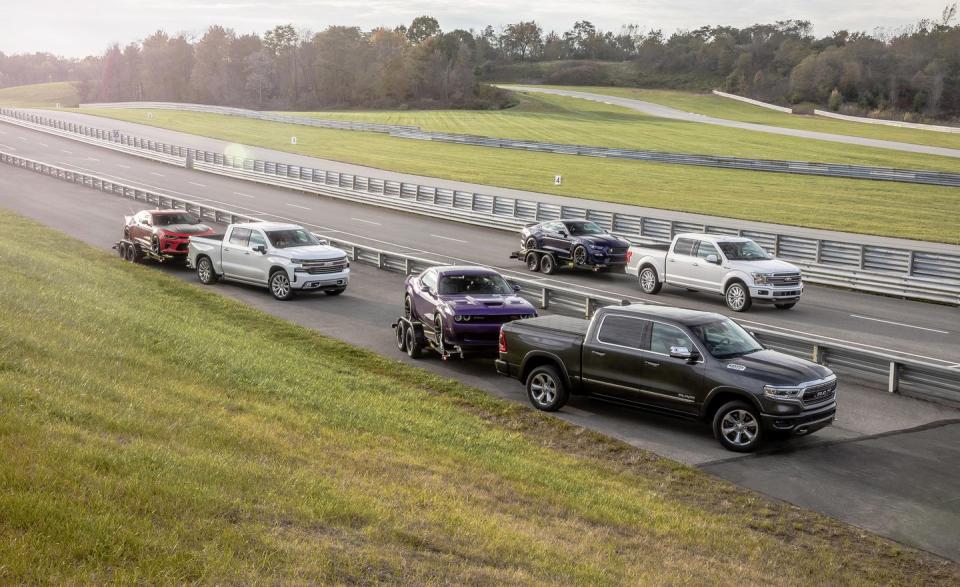
Chevrolet's Silverado is all-new for 2019, with new bodywork on a new frame. The optional V-8 fitted to this example displaces 6.2 liters like the brand's top offering from last year, but the engine, too, is fresh. Whereas last year's 6.2 saved fuel with a cylinder-deactivation program that shut off four cylinders under light loads, the 2019 engine runs a new scheme from supplier Delphi that can drop as many as six cylinders when conditions are right, running the engine on anything from eight to two pots. The Silverado tested here is the as-much-as-you-can-spend High Country version, which includes a two-speed transfer case, automatic stop-start, dual exhaust, body-color bumpers, LED lighting, and leather seats (heated and ventilated up front, heated outboard in the rear), and bases at $57,795. With a barrage of driving assists, 22-inch wheels, the upgraded engine (versus the base 5.3-liter V-8), and power-operated running boards, this one stickers at $67,420.
It's a big year in the full-size-truck market—the Ram 1500 is also new. Its 5.7-liter Hemi V-8, now available with a 48-volt motor-generator assist, nestles in a redesigned frame wrapped in fresh bodywork. Crew-cab trucks like the one here get a nice bump in rear legroom, too. There isn't a super-giganto Mega Cab yet, but the Rolls-Roycian 45.2 inches of stretch-out space means that the Ram sports 65 cubic feet of rear-seat room. Limited 4x4 models like this one, which base at $58,390, also boast an interior with such extraordinary attention to detail that it's hard to believe this truck could possibly roll out of a factory by the hundreds of thousands. A 19-speaker Harman/Kardon stereo, a suite of active driving assists, a panoramic sunroof, and the 5.7-liter Hemi with the optional eTorque 48-volt hybrid system jack the price for this one up to $69,190.
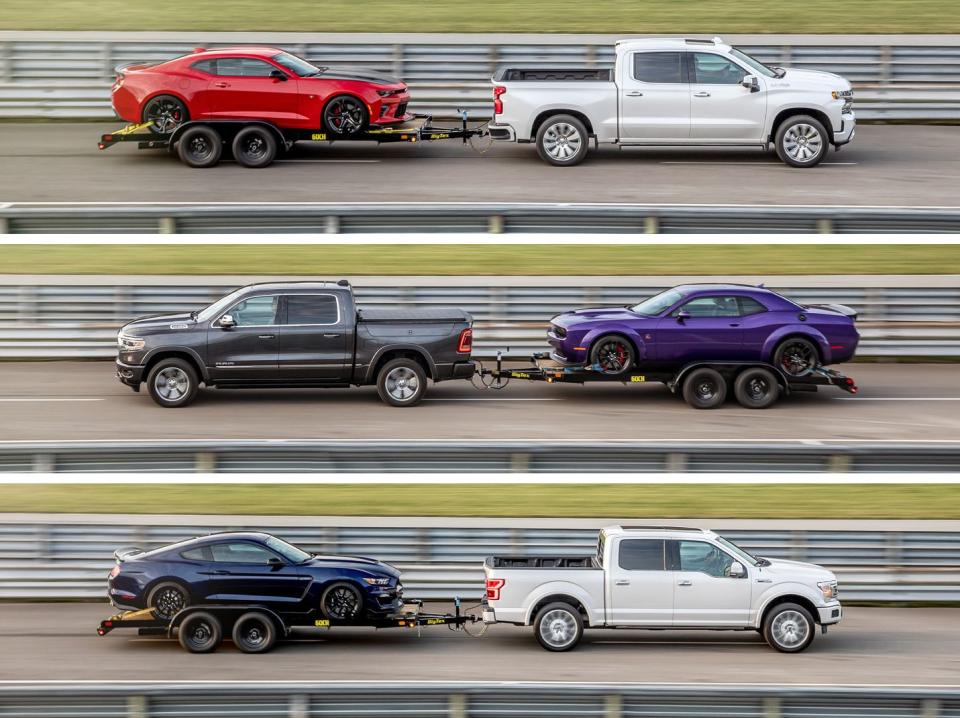
That seems like a lot until you peek at the Monroney for our Ford F-150. Wholly reimagined in "military-grade" Faygo can for 2015, the F-150 got a slight facelift last year that included a new grille and upgraded engines. Ford went a step further with the latter for 2019 by making the full-bore, Raptor-spec twin-turbo 3.5-liter EcoBoost with 450 horsepower and 510 pound-feet of torque standard in the top-of-the-line Limited model. (Lesser trims make do with 375 horsepower and 470 pound-feet.) At a base price of $72,055, the F-150 Limited comes preloaded with a panoramic sunroof, massaging front seats, power running boards, and assorted luxury trappings. This one arrived fitted with a tailgate step, a towing package, and a smattering of bed accessories that raised its price to an eye-watering $74,865.
With even the lowest as-tested price here creeping up on $70,000, these are undeniably lifestyle accessories more than tools. So we put them to work hauling their brands' respective sports cars to Pittsburgh International Race Complex, about 40 miles northwest of Pittsburgh, Pennsylvania. Because these trucks aren't just about hard work; they're about having fun in comfort. Let's see which is the best enabler.
Third Place: Chevrolet Silverado 1500
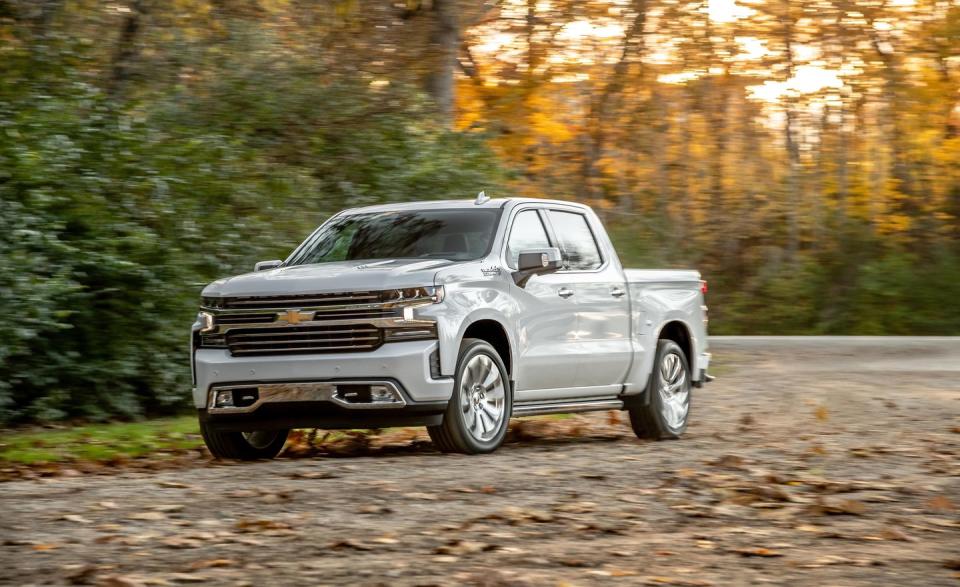
Highs: We’ll shortly be a high country. That’ll make this more tolerable.
Lows: Harsh ride, cheap interior.
Verdict: We expected far more in the way of refinement, cabin polish, andvalue from this all-new Chevy truck.
It's staggering just how stark the difference is between the Silverado and the two other trucks here. One logbook note called the Chevy "a $70,000 kick in the nuts." Technical editor David Beard wrote, "I like the engine in this truck, and that's it."
To be fair, there are a few other things to appreciate. The low seating height gives the Silverado a uniquely carlike driving position. The brake pedal feels like it was pulled straight from the Corvette, and a 175-foot stop from 70 mph is rather impressive for a 5500-pound truck—though the 5600-pound F-150 stopped even shorter. And because the Chevy's sunroof covers only the front seats, this truck has the most rear-seat headroom by a long shot. But the seats are flat, hard, and unsupportive, and the fronts don't massage you (like the Ford's) and the rears aren't cooled (like the Ram's).
Get out of the Ford and into the Chevy and you do appreciate the easy, natural torque of a large-displacement engine, and props to the Silverado's trick cylinder deactivation for putting the 6.2 ahead of a 3.5-liter in fuel economy, both with and without a trailer behind it. That just goes to show that no matter the cylinder count, displacement, or boost pressure, it takes fuel to make power. Also, it's pretty awesome that the second-quickest truck here ran a 13.9 at 100 mph in the quarter-mile.
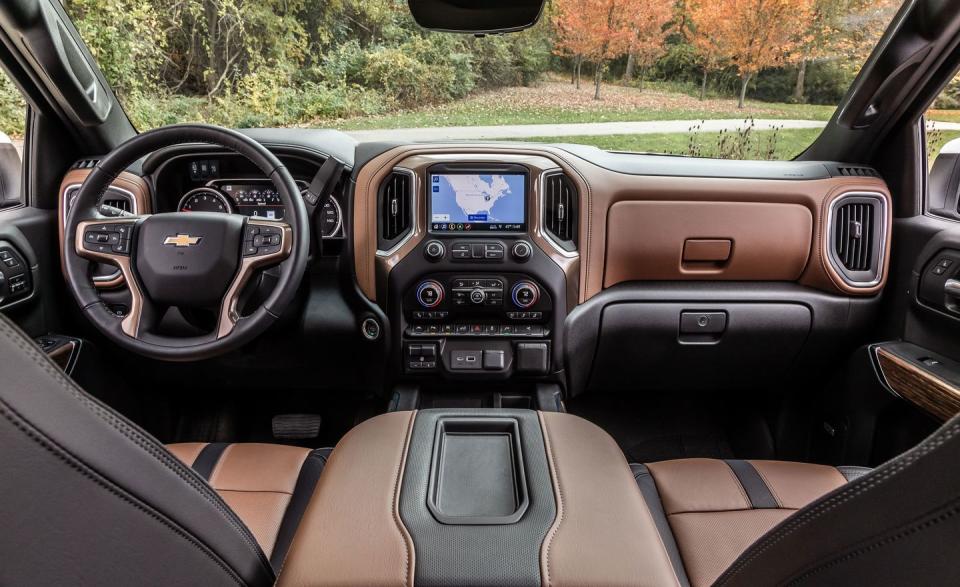
Our frustration with the Silverado is rooted in its ride and the noodly feel of the structure. Chevy followed its crosstown rival down the aluminum road only a short way, stamping the hood, doors, and tailgate from aluminum. The body and box are still steel. Chevy manages to undercut the Ford by 90 pounds just the same, though after driving the Silverado, we wished Chevy had put a little more beef into its structure. Those 22-inch wheels are the hammers, and the body is a dulcimer string. This truck shakes and vibrates so much that, bombing down a rough road, we expected to get a call from OnStar asking if we'd been in an accident. (We've had that experience before off-pavement.) At one point in our drive, as we were passing over a series of speed bumps, technical director Eric Tingwall radioed from the Ram at the back of the pack to say he could see the difference in ride quality between the Chevy and the Ford, watching the Silverado's multiple suspension oscillations as the F-150 would compress and rebound just once. And the Silverado suffered most from its trailer, with diagonal roadway seams initiating an unsettling wobble in the load. Although, while all three trucks have rearview camera modes that let the driver zoom in on the trailer hitch as he's backing up to it, only the Chevy has an additional camera fitted in the high-mount stop lamp to serve as a high-angle rearview mirror when a trailer is attached. The camera display takes over the rearview mirror when the driver flips the day/night switch, and it gives a far better view of traffic abaft than the tow truck usually has. It's such a helpful feature that we expect the other two trucks to adopt it within a couple years.
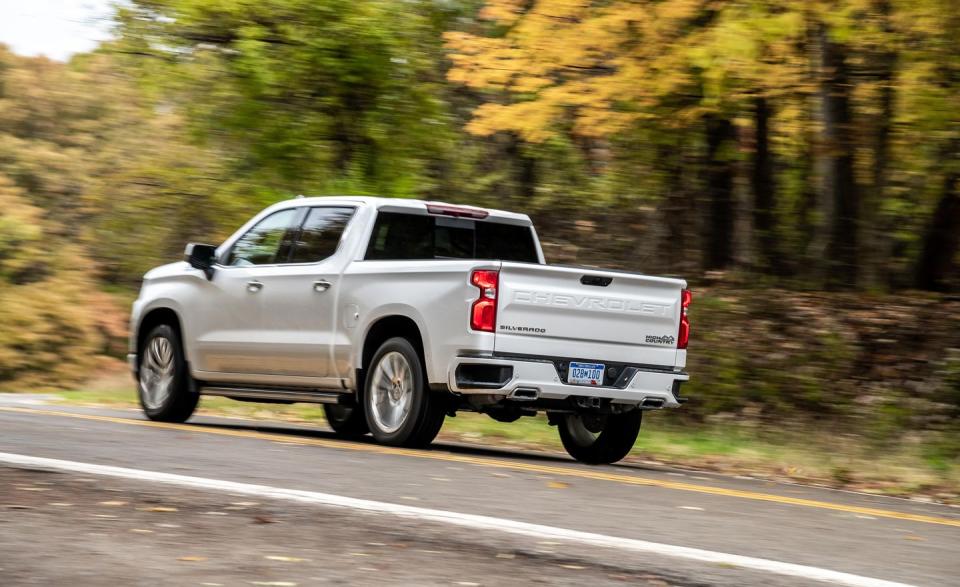
The Silverado's shortcomings, on the other hand, will be harder and more expensive for Chevy to address. There's nothing like a $70,000 Silverado to prove just how far GM hasn't come with its interiors. The plastics look and feel cheap, and the design, even in this High Country model, feels phoned in. Our jurors all agreed that few things about this truck feel new; Tingwall decreed it "a throwback to the days when pickup trucks were not family transportation." It's a far cry from the luxury toy-hauler experiences offered by Ford and Ram.
2nd Place: Ford F-150
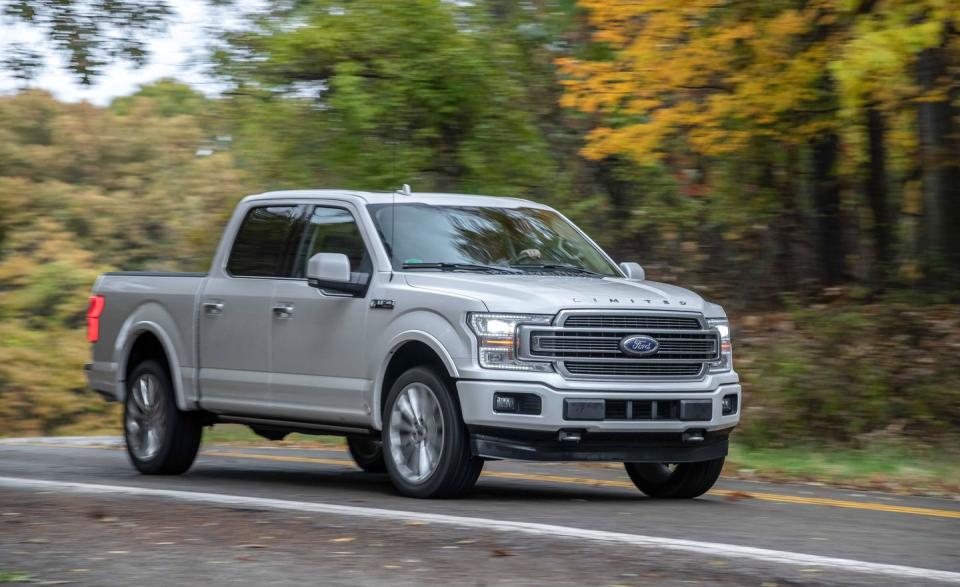
Highs: Powerful turbo six and seamless 10-speed, attractive inside and out.
Lows: The two-point spread is in the details, displacement doesn't determine consumption so much as power does.
Verdict: An excellent truck that could only be bested by an outstanding one.
Ford convincing truck buyers that a V-6, even one with turbos hanging off the sides, is a suitable replacement for a V-8 would be almost as surprising a development as any of these brands winning conquest sales from the others. But, especially in this high-output spec, the engine impresses. While its low-end response isn't as vigorous as the Chevy octopot's, its brute force takes the worry out of highway merges, even with three tons of trailer along for the ride.
The only stock truck we've ever tested that's outrun this F-150 was the old Dodge Ram SRT-10, and that was a standard-cab short-box truck packing a Viper V-10. That a leather-lined crew cab powered by a V-6 is knocking on that title—and running a 13.7 at 102 mph in the quarter-mile—is remarkable. While the six's muffled burr of an exhaust note isn't as stirring as that old Viper engine or either of the eights in the other trucks tested here, as Tingwall noted, "I'd happily trade engine character for performance in a utilitarian application like this." Ford also did a better job calibrating the jointly developed Ford-GM 10-speed transmission than GM did. The Silverado often required two separate shifts with a hesitation in between to find the right gear, as if it were reluctant to step all the way down. The Ford more often found the right ratio on the first try.
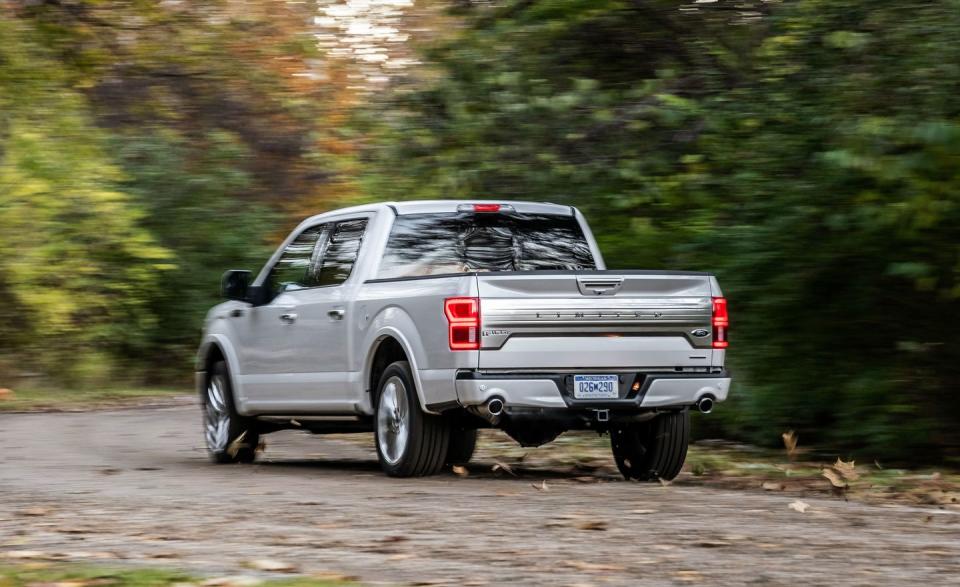
You could spend weeks divining the differences in ride quality between the Ford and the Ram, as both have commendably plush comportment with and without trailers hooked up. Bumps fade in a single well-damped suspension cycle, and there's none of the structural shudder that plagues the Silverado. We've been even more wowed by the ride in F-150s with smaller wheels, though, and would spec humbler rims than 22s were it our own money. But we all agreed that once the toy haulers were hooked up, the Ram was smoother and more controlled than the Ford.
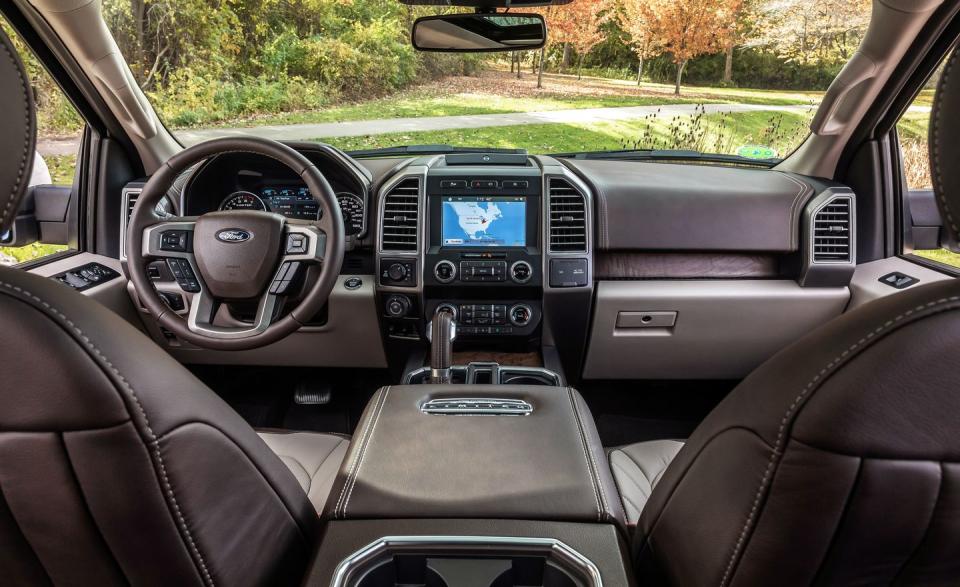
Even four years in, the interior of this truck looks great, with rich detailing like the crosshatch-brushed-metal-look trim around the HVAC vents, genuine ash wood panels behind the door handles that seem as if they were sourced from the Gibson guitar factory, and distressed and mottled leather on the seatbacks. Ford's secondary-control layout is easy to understand and use, and the massaging seats were welcomed by backs that had been tormented by the Silverado's ride. But in the end, we were ever so slightly swayed to Team Ram by the erstwhile Dodge's fabulous interior detailing and more composed trailering behavior.
1st Place: Ram 1500
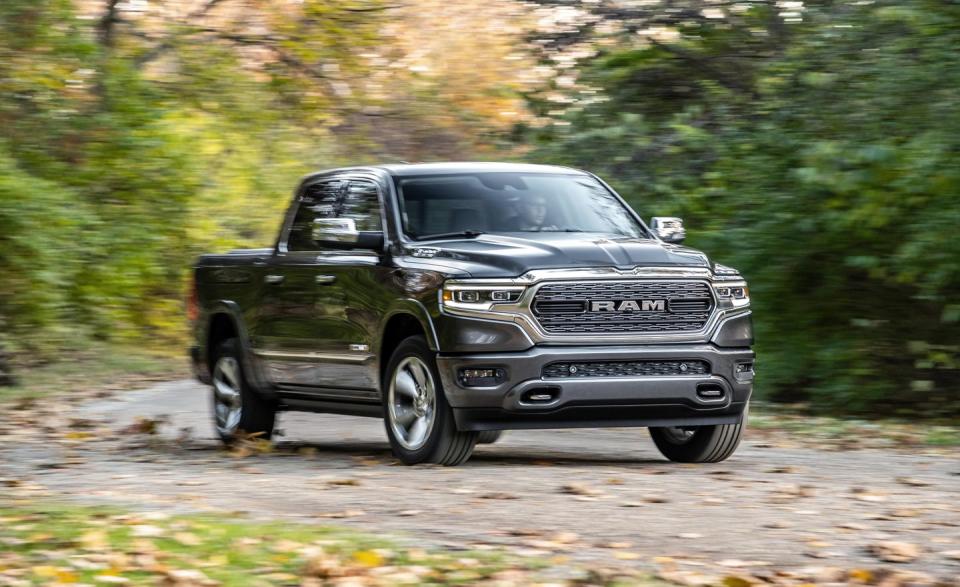
Highs: Interior suggests there’s still a tie to Daimler, velvety ride, Hemi roar.
Lows: Finished last in every single performance test, the heaviest here by a wide margin.
Verdict: A tugboat and a party barge in one; ready to tow your, er, tugboat or party barge.
It's a little clichéd to say of a tow vehicle that you don't even feel the trailer, but we were shocked by how literally true that is in the Ram. There's a slight laziness from the rear end when changing lanes, but other than that, it's easy to forget that the jerk tailgating you is actually a car you attached to your rear bumper. The air springs pump up to maintain ride height, the ride remains as imperturbable as it does when the truck is unladen, and the miles fade into, well, not memory, because there's nothing memorable about them except how unremarkable they are. This is an outstanding tow rig. Proof: The only complaint any of us could come up with regarding its trailering behavior was that the turn signals don't have a one-touch six-blink function in tow mode.
Even such a small omission is surprising, though, because the Ram is far and away the most thoughtfully executed full-size pickup in existence. For starters, it looks like a Mercedes-Benz S-class exploded inside. It looks more like the S-class in here than even an E-class does, particularly in the dark-blue/cream (Indigo/Frost per Ram) combo sported by this truck. The Limited's nickel-finish metallic trim and striped black wood mean even the standard black interior is handsome enough, but the no-cost two-tone option with contrasting stitching and piping seems ripped from the pages of a luxury-brand ordering guide. There are even little stitched-leather corsets on the A-pillar grab handles, and one staffer likened the filigrees sewn into the door panels and seats to lower-back tattoos. Speaking of Mercedes, did you know that the German word for said tattoos is Arschgeweih? It translates to "ass antlers."
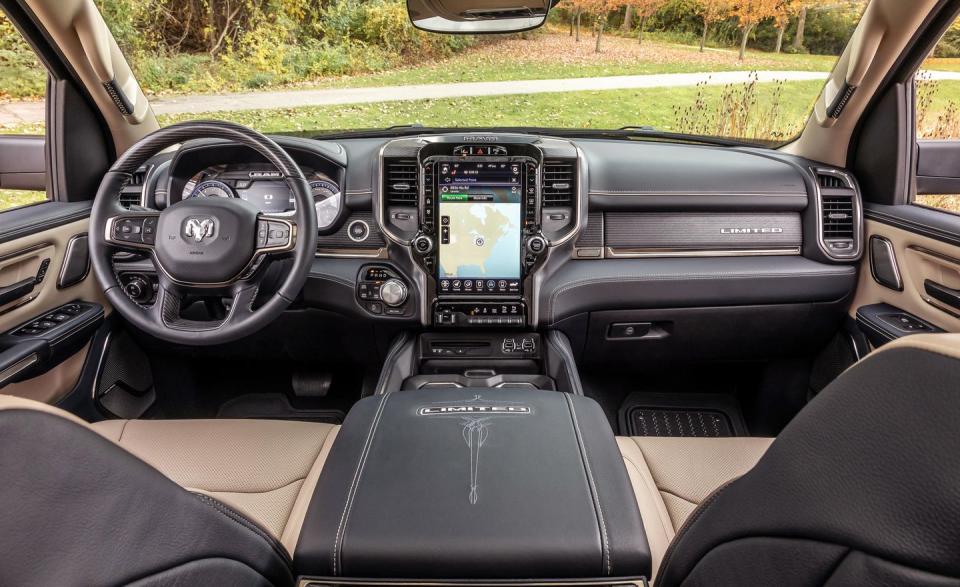
Staff technophiles liked that the huge 12.0-inch touchscreen can be split in two, say, to show Apple CarPlay on top and navigation on the bottom. And everybody was blown away by the 19-speaker Harman/Kardon sound system, especially the brushed-metal speakers embedded above the rear-seat passengers' heads. While the Ram's enormous two-row sunroof, like the Ford's, cuts into headroom for the tallest rear occupants, the Ram's rear seats slide and recline, allowing those passengers to choose their priority: head- or legroom.
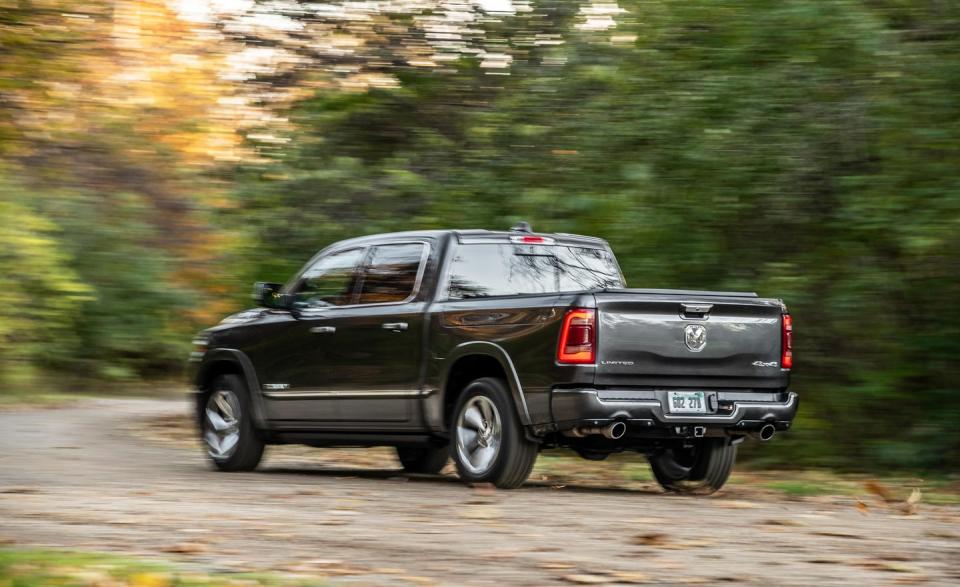
The Ram is not without its imperfections. It, too, uses some aluminum in its construction—the tailgate, engine mounts, steering gear, lower front control arms (the uppers are composite), and transmission crossmember—but at 6102 pounds, it's 500 and 600 pounds heavier, respectively, than the Ford and the Chevy. Combine that with the weakest (but best-sounding) engine of the bunch, and it's slow. FCA claims the $1450 eTorque system is good for a momentary torque boost of up to 130 pound-feet, but neither the seat of our pants nor our stopwatch could attest to that. Not only is the Ram slow, but its brake pedal is, in Tingwall's words, "softer than the belly of a 23-pound cat." And he'd know. When his tabby, Scooter, lays down—so always—she looks like a puddle of cat with a head floating in it.
The Ram, on the other hand, is a gooey puddle of luxury sedan with a tow hitch poking out from the rear bumper. It's a toy hauler that is itself a toy. It's our new favorite full-size pickup. And it's worth the money.
You Might Also Like

 Yahoo Autos
Yahoo Autos 